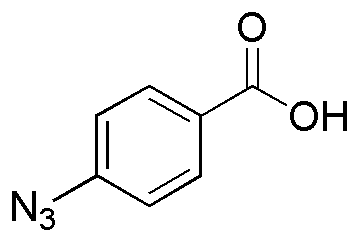4-Azidobenzoic acid is widely utilized in research focused on:
- Organic Synthesis: This compound serves as a versatile building block in organic chemistry, facilitating the synthesis of various azide-containing compounds, which are crucial for creating complex molecules.
- Click Chemistry: Its azide functional group makes it ideal for click chemistry applications, allowing for efficient and selective reactions with alkynes, which are valuable in drug development and materials science.
- Bioconjugation: In biochemistry, it is used to label biomolecules, enabling the study of protein interactions and cellular processes, which is essential for developing new therapeutic strategies.
- Polymer Chemistry: The compound can be incorporated into polymer matrices to create materials with specific properties, such as enhanced reactivity or functionality, beneficial in the development of smart materials.
- Photochemistry: It can be utilized in photochemical reactions, where its azide group can undergo transformations upon light exposure, making it useful in creating light-responsive materials.
General Information
Properties
Safety and Regulations
Applications
4-Azidobenzoic acid is widely utilized in research focused on:
- Organic Synthesis: This compound serves as a versatile building block in organic chemistry, facilitating the synthesis of various azide-containing compounds, which are crucial for creating complex molecules.
- Click Chemistry: Its azide functional group makes it ideal for click chemistry applications, allowing for efficient and selective reactions with alkynes, which are valuable in drug development and materials science.
- Bioconjugation: In biochemistry, it is used to label biomolecules, enabling the study of protein interactions and cellular processes, which is essential for developing new therapeutic strategies.
- Polymer Chemistry: The compound can be incorporated into polymer matrices to create materials with specific properties, such as enhanced reactivity or functionality, beneficial in the development of smart materials.
- Photochemistry: It can be utilized in photochemical reactions, where its azide group can undergo transformations upon light exposure, making it useful in creating light-responsive materials.
Documents
Safety Data Sheets (SDS)
The SDS provides comprehensive safety information on handling, storage, and disposal of the product.
Product Specification (PS)
The PS provides a comprehensive breakdown of the product’s properties, including chemical composition, physical state, purity, and storage requirements. It also details acceptable quality ranges and the product's intended applications.
Certificates of Analysis (COA)
Search for Certificates of Analysis (COA) by entering the products Lot Number. Lot and Batch Numbers can be found on a product’s label following the words ‘Lot’ or ‘Batch’.
Número de catálogo
Número de lote/lote
Certificates Of Origin (COO)
This COO confirms the country where the product was manufactured, and also details the materials and components used in it and whether it is derived from natural, synthetic, or other specific sources. This certificate may be required for customs, trade, and regulatory compliance.
Número de catálogo
Número de lote/lote
Safety Data Sheets (SDS)
The SDS provides comprehensive safety information on handling, storage, and disposal of the product.
DownloadProduct Specification (PS)
The PS provides a comprehensive breakdown of the product’s properties, including chemical composition, physical state, purity, and storage requirements. It also details acceptable quality ranges and the product's intended applications.
DownloadCertificates of Analysis (COA)
Search for Certificates of Analysis (COA) by entering the products Lot Number. Lot and Batch Numbers can be found on a product’s label following the words ‘Lot’ or ‘Batch’.
Número de catálogo
Número de lote/lote
Certificates Of Origin (COO)
This COO confirms the country where the product was manufactured, and also details the materials and components used in it and whether it is derived from natural, synthetic, or other specific sources. This certificate may be required for customs, trade, and regulatory compliance.


